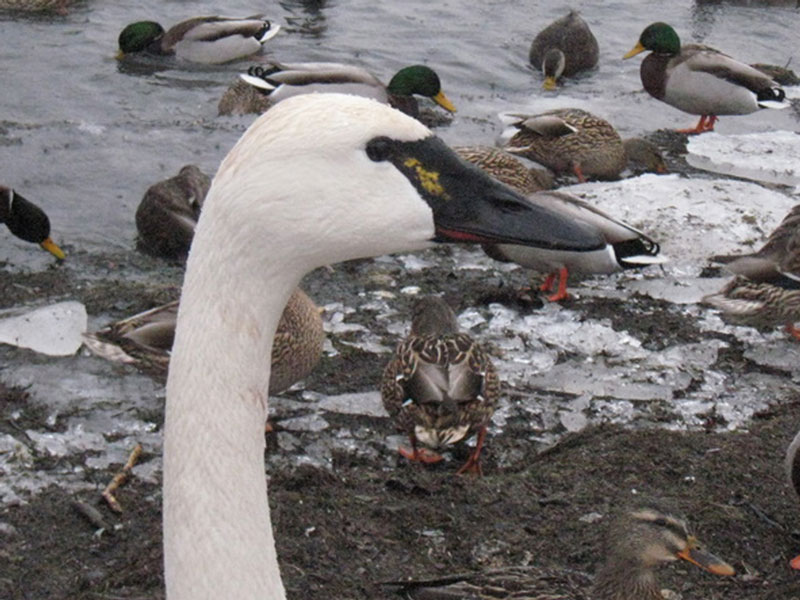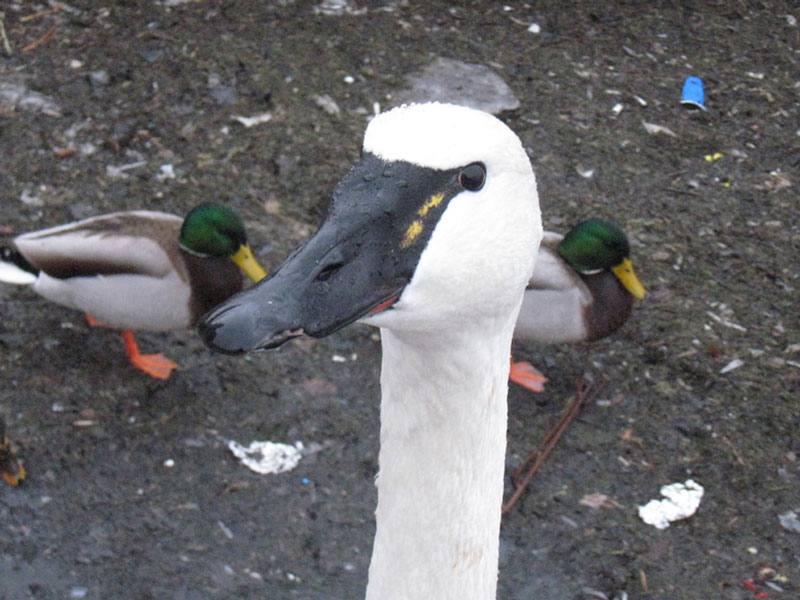
In a previous post I’ve talked about Trumpeter Swans with yellow bill spots as a source of confusion with Tundra Swan. I speculated that the yellow spots might be showing because the birds are leucistic (lacking melanin). The responses to that post are worthy of a follow-up. Harry Lumsden, who has studied the reintroduced Trumpeter Swans of Ontario and knows them as individuals, says that yellow bill spots are rare but are shown by a small percentage of Ontario Trumpeters.
Leucistic swans do exist (Harry currently knows of three in Ontario) and can be recognized throughout their life by their pale yellowish legs. They show yellow and red patches on their bills until age two, some show yellow spots until age four, but otherwise their bills are all black like normal Trumpeters. Most of the swans showing yellow bill spots (like bird C24 shown in the photos here) have dark legs and are not leucistic.
Another interesting point is that this swan shows a rounded border of feathering on the forehead. This is typical of Tundra Swan, most Trumpeters have a more pointed extension of white feathers on the forehead. Harry Lumsden says this is another rare variation shown by some Ontario Trumpeter Swans.
Given the yellow bill spots and the rounded forehead feathering, it’s no wonder birders have been confused by this individual. We might even start to consider the possibility of a hybrid, but Harry has watched this individual swan from hatching, he knows its parents and grandparents, and there is no question that it is a pure Trumpeter Swan. It’s a good lesson in variation and the fallibility of field marks.



Of our last year’s brood of seven trumpeter cygnets at Bluffers Park, four are showing yellow lores to varying degrees. Interestingly their mother 083 carries the leucistic gene (she has a leucistic sister, H11). I will send a photo.
I have seen and photographed one of these trumpeters with yellow lore in Toronto at Bluffers park. I have two good photos of this swan if there is a way of posting them. It was suggested by Mike Burrell that I contact this website.
In the past I have seen C24 and reported it as a tundra swan
I photographed what used to be Trumpeter Swan C24 on Nov 25, 2013 at Bluffers Park in Scarborough. It no longer has any wing tags. The yellow area is larger and brighter now, and it is a more solid yellow patch. I have close up shots of the piece missing from the bill. While I was watching this bird, I noticed that it didn’t look at all like a Tundra Swan. It was the same size as the Trumpeters, it carried its neck the same way, it was not whiter. The feathering on the forehead did cut somewhat quickly across the top of the bill without coming to a point, but other than that, it certainly looked like a Trumpeter. I have one shot showing a thick leg that is solid black. I would normally have seen the yellow patch, and immediately called the bird a Tundra, but having watched it for a good long while, I decided to search for info on hybrids, at which point I came across this blog.
Hmmm…I’m wondering if we have a similar Trumpeter here in Oregon (William Finley Wildlife Refuge) as it seems to be a Trumpeter and with other Trumpeters. See https://photos.app.goo.gl/zbgKHUUP9BgPm8oe9
I saw a yellow foot Trumpeter swan at the Leslie Spit in Toronto (T64) for the first time!
Saw T64 today in Vaughan, ON. I guess they travel around. The pair of swans have been in our neighborhood pond since last month.
This bird is actually a Tundra Swan. It has all the characteristics of a Tundra. The U shape forehead, the bent line on the eye-mandible bill line (not well seen on this angle with this photo). Concave shape bill and eye is not included in bill like Trumpeters. Also, about 15% of Tundra swans have red lines on the mandible. Some Tundras have no yellow on bill, others more than a dot, some Tundra’s have yellow and red line, others (vast majority) have yellow on the lore. The other false ID is the 2012 claim of a Trumpeter with yellow. This one really shows the bent line on the bill line, and U on forehead and eye distinct from bill. Thus, these are, in truth, Tundra swans.
In the Sibley Field Guide: Trumpeter Swan leg/foot color is incorrect. The Trumpeter has salmon pink legs and feet as very young cygnets. By the time they have the dark gray feathers their legs are mottled black/yellow/orange. It stays this way the entire first year. Gradually over the next 3 years the legs turn black. They are solid black by the age of 4 years. Thus, you can age Trumpeters by their leg color during the first 3 years.
Tundra swans have mottled legs that turn all black by December of their first year. You cannot age Tundra Swans past their first year as plumage is all white and legs all black.